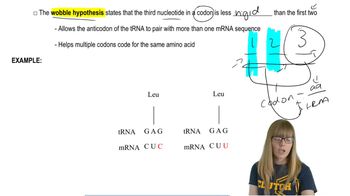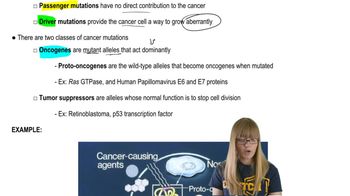Table of contents
- 1. Introduction to Genetics51m
- 2. Mendel's Laws of Inheritance3h 37m
- 3. Extensions to Mendelian Inheritance2h 41m
- 4. Genetic Mapping and Linkage2h 28m
- 5. Genetics of Bacteria and Viruses1h 21m
- 6. Chromosomal Variation1h 48m
- 7. DNA and Chromosome Structure56m
- 8. DNA Replication1h 10m
- 9. Mitosis and Meiosis1h 34m
- 10. Transcription1h 0m
- 11. Translation58m
- 12. Gene Regulation in Prokaryotes1h 19m
- 13. Gene Regulation in Eukaryotes44m
- 14. Genetic Control of Development44m
- 15. Genomes and Genomics1h 50m
- 16. Transposable Elements47m
- 17. Mutation, Repair, and Recombination1h 6m
- 18. Molecular Genetic Tools19m
- 19. Cancer Genetics29m
- 20. Quantitative Genetics1h 26m
- 21. Population Genetics50m
- 22. Evolutionary Genetics29m
19. Cancer Genetics
Cancer Mutations
Problem 9b
Textbook Question
Define tumor-suppressor genes. Why is a mutated single copy of a tumor-suppressor gene expected to behave as a recessive gene?
 Verified step by step guidance
Verified step by step guidance1
Understand the role of tumor-suppressor genes: These genes are responsible for regulating cell growth and division, ensuring that cells do not proliferate uncontrollably.
Recognize the function of tumor-suppressor genes: They act as a brake on cell division, repair DNA mistakes, or tell cells when to die (a process known as apoptosis).
Identify the impact of mutations: A mutation in a tumor-suppressor gene can lead to a loss of function, meaning the gene can no longer regulate cell growth effectively.
Explain the concept of recessiveness: For a tumor-suppressor gene to lose its function completely, both copies (alleles) of the gene must be mutated. This is because the presence of one normal (wild-type) allele can often compensate for the mutated one, maintaining some level of normal function.
Conclude why a single mutated copy behaves recessively: Since the normal allele can still perform the gene's function, the mutation in one allele does not manifest in a dominant manner, thus behaving as a recessive trait.
Recommended similar problem, with video answer:
 Verified Solution
Verified SolutionThis video solution was recommended by our tutors as helpful for the problem above
Video duration:
1mPlay a video:
Was this helpful?
Key Concepts
Here are the essential concepts you must grasp in order to answer the question correctly.
Tumor-Suppressor Genes
Tumor-suppressor genes are segments of DNA that encode proteins responsible for regulating cell growth and division. They act as a safeguard against uncontrolled cell proliferation, which can lead to tumor formation. When functioning properly, these genes help maintain genomic stability and prevent the development of cancer.
Recommended video:
Guided course

Mapping Genes
Recessive Alleles
A recessive allele is a variant of a gene that does not manifest its trait in the presence of a dominant allele. For tumor-suppressor genes, both copies (one from each parent) must be mutated or inactivated for the cancerous phenotype to occur. This is because the remaining functional copy can still produce enough protein to suppress tumor growth, illustrating the recessive nature of these mutations.
Recommended video:
Guided course

New Alleles and Migration
Two-Hit Hypothesis
The two-hit hypothesis, proposed by Alfred Knudson, explains how mutations in tumor-suppressor genes lead to cancer. It posits that both alleles of a tumor-suppressor gene must be inactivated for tumorigenesis to occur. The first 'hit' can be a hereditary mutation, while the second is often acquired, emphasizing the need for both copies to be affected for the recessive behavior to manifest in cancer development.
Recommended video:
Guided course

Translation:Wobble Hypothesis

 4:50m
4:50mWatch next
Master Cancer Mutations with a bite sized video explanation from Kylia Goodner
Start learningRelated Videos
Related Practice


